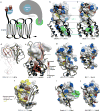What Do Structures Tell Us About Chemokine Receptor Function and Antagonism?
- PMID: 28532213
- PMCID: PMC5764094
- DOI: 10.1146/annurev-biophys-051013-022942
What Do Structures Tell Us About Chemokine Receptor Function and Antagonism?
Abstract
Chemokines and their cell surface G protein-coupled receptors are critical for cell migration, not only in many fundamental biological processes but also in inflammatory diseases and cancer. Recent X-ray structures of two chemokines complexed with full-length receptors provided unprecedented insight into the atomic details of chemokine recognition and receptor activation, and computational modeling informed by new experiments leverages these insights to gain understanding of many more receptor:chemokine pairs. In parallel, chemokine receptor structures with small molecules reveal the complicated and diverse structural foundations of small molecule antagonism and allostery, highlight the inherent physicochemical challenges of receptor:chemokine interfaces, and suggest novel epitopes that can be exploited to overcome these challenges. The structures and models promote unique understanding of chemokine receptor biology, including the interpretation of two decades of experimental studies, and will undoubtedly assist future drug discovery endeavors.
Keywords: G protein–coupled receptor; allostery; crystallography; druggability; molecular modeling; receptor activation.
Figures





References
-
- Andrews G, Jones C, Wreggett KA. An Intracellular Allosteric Site for a Specific Class of Antagonists of the CC Chemokine G Protein-Coupled Receptors CCR4 and CCR5. Molecular Pharmacology. 2008;73:855–67. - PubMed
-
- Baggiolini M. Chemokines and leukocyte traffic. Nature. 1998;392:565–68. - PubMed
-
- Ballesteros JA, Weinstein H. Integrated methods for the construction of three-dimensional models and computational probing of structure-function relations in G protein-coupled receptors. In: Sealfon SC, editor. Methods in Neurosciences: Receptor Molecular Biology. San Diego: Academic Press; 1995. pp. 366–428.
-
- Bertini R, Allegretti M, Bizzarri C, Moriconi A, Locati M, et al. Noncompetitive allosteric inhibitors of the inflammatory chemokine receptors CXCR1 and CXCR2: Prevention of reperfusion injury. Proceedings of the National Academy of Sciences of the United States of America. 2004;101:11791–96. - PMC - PubMed
Publication types
MeSH terms
Substances
Grants and funding
LinkOut - more resources
Full Text Sources
Other Literature Sources

